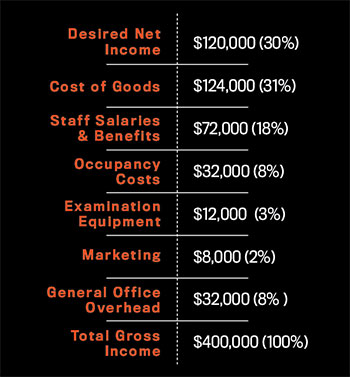“Chair cost” is the dollar figure an optometrist must produce on a per hour or per patient basis to support his or her practice overhead. The usual rationale for calculating chair cost is to make sure an OD doesn’t price his services below what it actually costs to provide them.
To illustrate why chair cost might not be the best way to manage expenses, let’s take a simple example of a doctor who is grossing $400,000 and netting 30 percent, or $120,000.
Assuming his Cost Of Goods Sold (COGS) was 31%, the Fixed Overhead for his practice would be 100% – 30% (net) – 31% (COGS) = 39% of his collected gross revenues.
That means he is spending 39% x $400,000 = $156,000 for his rent, staff salaries, marketing, equipment, supplies and general office overhead.
If this doctor sees patients 30 hours per week, 46 weeks out of the year, his “chair time” is 30 hours x 46 weeks = 1,380 hours per year.
To calculate his chair costs, we divide his Fixed Overhead ($156,000) by the number of hours he sees patients. In this case, $156,000/1,380 hours = $113 per hour. That is how I would calculate chair costs.
Advertisement
What that tells me, in theory at least, is that this doctor must generate at least $113 per hour in gross margins (that is what he collects over and above his Cost Of Goods) to pay his Fixed Overhead. Only then does he start making money for himself.
THE TROUBLE WITH CHAIR COSTS AS A MANAGEMENT TOOL
Yes, the math is straightforward. But chair costs as a management tool is not a great idea for these three reasons:
1. The concept of chair cost implies that if there is a problem, it lies with the fees charged, not the way a doctor is managing his overhead. However, we have consulted with many low-net (29 percent or below) optometrists, who had adequate gross revenue, but didn’t do a good job of managing expenses. For example, overstaffing can be a problem since there are more salaries to pay (higher overhead), which leads to a higher chair cost figure.
2. Optometrists don’t produce income in fixed units of time the way taxi drivers or lawyers do.
In the real world, some no-charge follow-up visits take longer than a complete exam for which ODs receive a fee. That’s just the way it works, because they charge by the procedure instead of by the hour.
3. Finally, if the chair cost number is too high, it doesn’t tell an OD what to do about it. In the past, our hypothetical doctor was simply advised to raise his fees to private pay patients to match his cost of doing business.
Advertisement
Now doctors often find themselves in a situation where they can’t pass on increased operating costs (in the form of higher prices) to their patients because so many patients are using managed care.
IT’S THE NET THAT COUNTS
It’s been our experience that many optometric practices have room to reduce their overhead and still provide the same high level of care. So, if an OD is not in a position to increase her fees, we recommend that she focus her management energy on controlling practice expenses.

In general, the most practical way to do that is to assign an annual budget number to each of the key expense areas. For example, if her practice’s gross income is $400,000, she might create a budget like the one to the right:
Unlike calculating chair costs, creating a budget like the one above can help you locate specific problem areas and address them directly. If an OD does that, she’ll find her expenses going down and her net income going up.
Nathan Hayes is a finance consultant at IDOC supporting private optometry practice owners on the business side of their practices. His expertise includes financial and productivity benchmarking, growth strategies, cash flow management, exit strategies, partnerships and practice leadership.
Advertisement
This article originally appeared in the March 2017 edition of GO/OD.